
Landscape with Three Figures is an oil on canvas painting by Nicolas Poussin, from c. 1645-1650. It is held now in the Museo del Prado, in Madrid. [1]

Landscape with Three Figures is an oil on canvas painting by Nicolas Poussin, from c. 1645-1650. It is held now in the Museo del Prado, in Madrid. [1]
The painting depicts a bucholic landscape, where the three main human figures represented appear to be of minimal importance, while others are also visible. Poussin approached this genre late in his career, from 1648 onwards, as it was not highly valued within the academic circles nor was it part of the classical genres. In this painting its noticeable the achievements of 17th century painting in terms of reaching a landscape where the atmosphere "is a kind of substance of space, which can fill the whole painting, making it a unit." [2]

Christoph Ludwig Agricola was a German landscape painter and etcher. He was born and died in Regensburg (Ratisbon).

Baroque painting is the painting associated with the Baroque cultural movement. The movement is often identified with Absolutism, the Counter Reformation and Catholic Revival, but the existence of important Baroque art and architecture in non-absolutist and Protestant states throughout Western Europe underscores its widespread popularity.
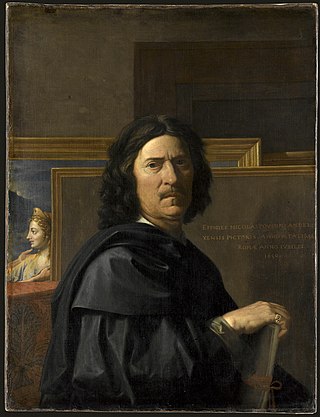
Nicolas Poussin was a French painter who was a leading painter of the classical French Baroque style, although he spent most of his working life in Rome. Most of his works were on religious and mythological subjects painted for a small group of Italian and French collectors. He returned to Paris for a brief period to serve as First Painter to the King under Louis XIII and Cardinal Richelieu, but soon returned to Rome and resumed his more traditional themes. In his later years he gave growing prominence to the landscape in his paintings. His work is characterized by clarity, logic, and order, and favors line over color. Until the 20th century he remained a major inspiration for such classically-oriented artists as Jacques-Louis David, Jean-Auguste-Dominique Ingres and Paul Cézanne.

André Félibien, sieur des Avaux et de Javercy, was a French chronicler of the arts and official court historian to Louis XIV of France.

Sébastien Bourdon was a French painter and engraver. His chef d'œuvre is The Crucifixion of St. Peter made for the cathedral of Notre Dame.
Events from the year 1648 in art.
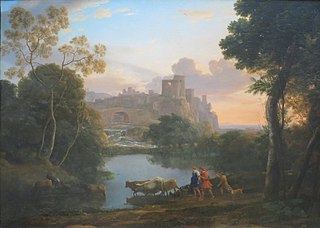
In painting, staffage are the human and animal figures depicted in a scene, especially a landscape, that are not the primary subject matter of the work. Typically they are small, and there to add an indication of scale and add interest.

The Funeral of Phocion is a 1648 landscape painting, also known as The Burial of Phocion, Landscape with the Funeral of Phocion and Landscape with the Body of Phocion Carried out of Athens, by the French artist Nicolas Poussin. Phocion was an Athenian statesman from the 4th century BC.

Landscape with Polyphemus is a 1649 oil painting by French artist Nicolas Poussin. It is held in the Hermitage Museum, in Saint Petersburg.

The Four Seasons was the last set of four oil paintings completed by the French painter Nicolas Poussin (1594–1665). The set was painted in Rome between 1660 and 1664 for the Duc de Richelieu, the grand-nephew of Cardinal Richelieu. Each painting is an elegiac landscape with Old Testament figures conveying the different seasons and times of the day. Executed when the artist was in failing health suffering from a tremor in his hands, the Seasons are a philosophical reflection on the order in the natural world. The iconography evokes not only the Christian themes of death and resurrection but also the pagan imagery of classical antiquity: the poetic worlds of Milton's Paradise Lost and Virgil's Georgics. The paintings currently hang in a room on their own in the Louvre in Paris.
By his absolute humility, by his effacement of himself, by his refusal to use any tricks or overstate himself, Poussin has succeeded in identifying himself with nature, conceived as a manifestation of the divine reason. The Seasons are among the supreme examples of pantheistic landscape painting.
Jamais peut-être, dans toute la peinture occidentale, des choses aussi nombreuses et parfois si difficiles n'avaient été dites avec une telle simplicité. Jamais un peintre ne s'était aussi pleinement identifié à l'ordre du monde. Mais cette identification n'est ni « une projection » ni une confidence : là est le sens de cette impersonalité que l'on a pu reprocher à Poussin, et qui fait sa grandeur.

A Dance to the Music of Time is a painting by Nicolas Poussin in the Wallace Collection in London. It was painted between c. 1634 and 1636 as a commission for Giulio Rospigliosi, who according to Gian Pietro Bellori dictated its detailed iconography. The identity of the figures remains uncertain, with differing accounts.

Landscape with Orpheus and Eurydice is a 124 × 200 cm oil-on-canvas painting by the French artist Nicolas Poussin, painted between 1650 and 1653. It depicts a mythological subject in the classical style and is in the collection of the Louvre in Paris.

The Inspiration of the Poet is an oil-on-canvas in the classical style by the artist Nicolas Poussin, painted between 1629 and 1630. It is held and exhibited at the Louvre, in Paris.
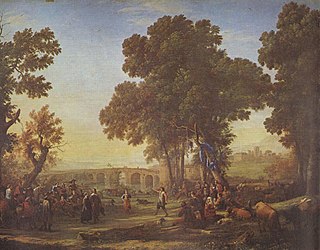
Village Fête is an oil-on-canvas by French artist of the Baroque Claude Lorrain, painted in 1639 and given to Louis XIV in 1693 together with its companion Seaport at Sunset, by landscape architect and gardener André Le Nôtre. It is currently held and exhibited at the Louvre in Paris.

Crescenzio Onofri or Crescenzio d'Onofri was an Italian landscape painter, draughtsman and engraver who worked in Rome and Florence. A presumed pupil of Gaspard Dughet he collaborated with many specialist figure painters of his time.
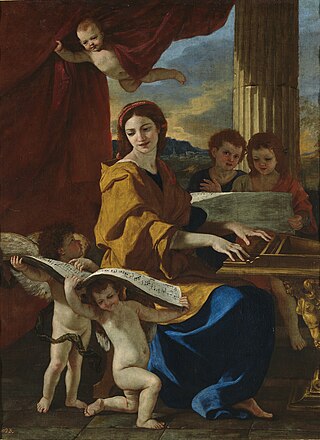
Saint Cecilia is a painting by Nicolas Poussin, from 1627-1628. It is held in the Prado Museum, in Madrid. It depicts Saint Cecilia playing a keyboard instrument, possibly a harpsichord. Two cherubs in front of her hold up a scroll with a musical score, whilst two angels sing in the background and a third cherub lifts a curtain.
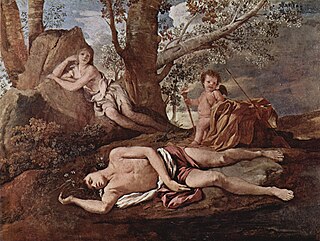
Echo and Narcissus is an oil painting by French artist Nicolas Poussin, from 1627-1628. It measures 74 by 100 cm and is held in the Louvre, in Paris.

Spanish Baroque painting refers to the style of painting which developed in Spain throughout the 17th century and the first half of the 18th century. The style appeared in early 17th century paintings, and arose in response to Mannerist distortions and idealisation of beauty in excess, appearing in early 17th century paintings. Its main objective was, above all, to allow the viewer to easily understand the scenes depicted in the works through the use of realism, while also meeting the Catholic Church's demands for 'decorum' during the Counter-Reformation.

The Death of Germanicus is a painting made in 1627 by Nicolas Poussin for Francesco Barberini. It is kept at the Minneapolis Institute of Art.